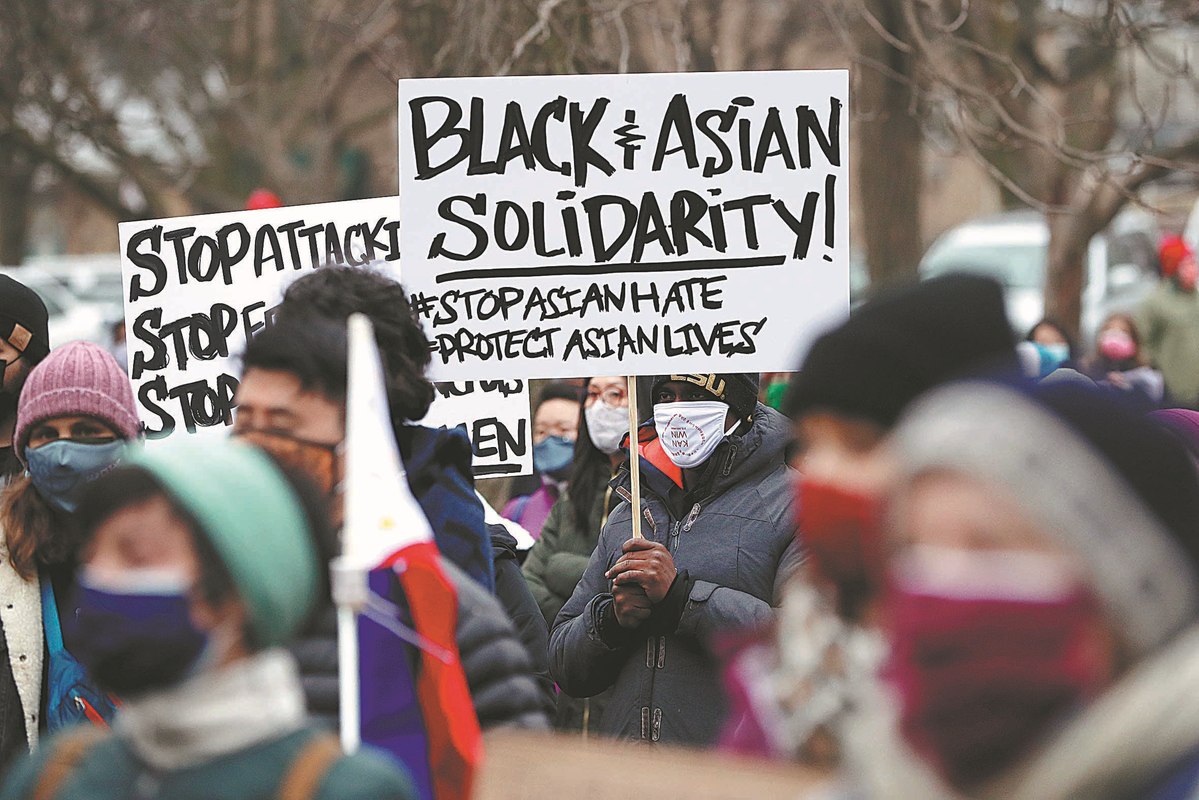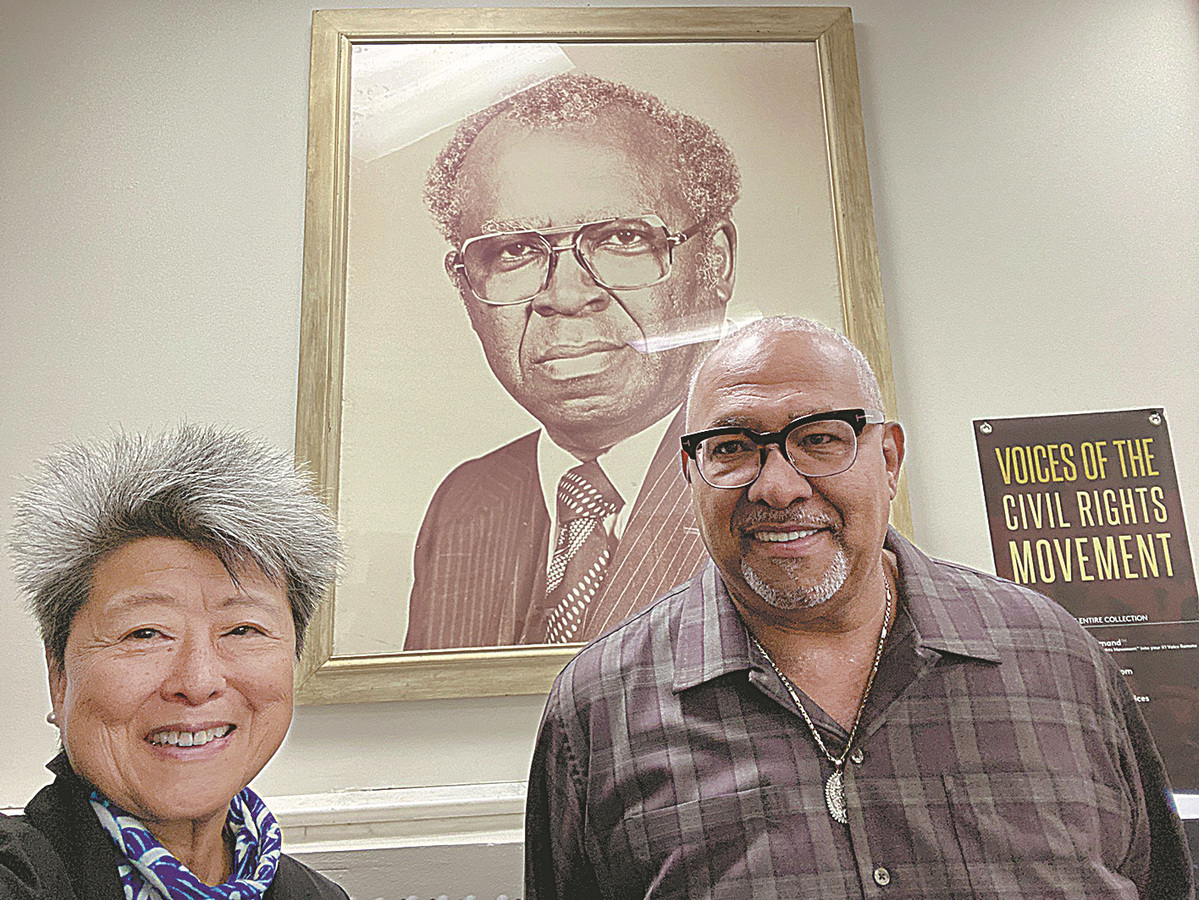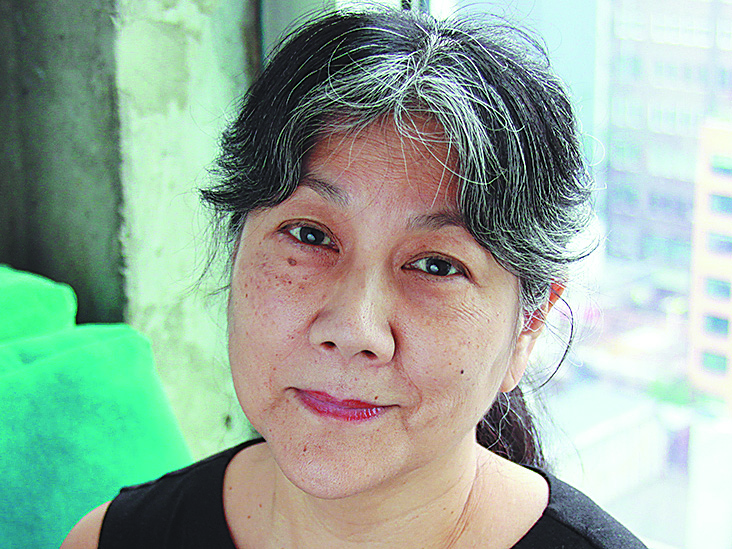
Expressions of solidarity between minority groups, such as at this rally in Chicago in March last year, have been growing. SHAFKAT ANOWAR/AP
People of African and Asian origins have long shared a cause in a hostile US
在充满种族歧视的美国,亚非少数族裔一直都在做着同样的抗争
Helen Zia's childhood memories of events on Aug 28, 1963, have never left her. She was in Washington, DC, on a road trip with her father and a brother. "We were driving through DC on our way back home to New Jersey. I remember looking out the car window at so many black people, wearing their Sunday best clothing", recalls Zia, now long recognized as a campaigner who helped make Asian Americans aware of their rights in a nation where many viewed them with suspicion or hostility.
1963年8月28日发生的事深深印在海伦·齐亚的童年记忆中。当时她与父亲和一个兄弟一起公路旅行路过华盛顿特区。齐亚回忆道:“我们在回新泽西州的路上开车穿过华盛顿特区。我记得从车窗望出去,有很多穿着得体的黑人。”齐亚现在是一名帮助亚裔美国人维权的活动家,在这个国家,他们遭受了许多质疑或敌意。
Back then, the 11-year-old had no idea that she was witnessing the largest public protest that the United States would see in the 20th century.
当时,11岁的齐亚还不知道,她目睹了美国20世纪最大规模的公众抗议活动。
The March on Washington for Jobs and Freedom, or simply the Great March on Washington as it's known today, drew a quarter of a million people onto the streets demanding civil and economic rights for black Americans.
在华盛顿举行的争取就业和自由游行(如今所说的“华盛顿大游行”)吸引了25万人走上街头,为美国黑人争取公民权和经济权。
In the crowd, which extended from the national capital's Lincoln Memorial all the way to the Washington Monument and beyond, were Horace Sheffield Jr, a rising black union leader, and his 9-year-old son Horace Sheffield III. The younger Sheffield is now the executive director of the Detroit Association of Black Organizations, which was set up by his father in 1979 to consolidate the city's groups representing black civil rights struggles.
游行队伍从林肯纪念堂一直排到华盛顿纪念碑等地,一个初露头角的黑人工会领袖小霍勒斯·谢菲尔德和他9岁的儿子霍勒斯·谢菲尔德三世也在游行队伍中。谢菲尔德三世现任底特律黑人组织协会执行董事,该协会由其父在1979年成立,旨在团结底特律代表黑人民权斗争的团体。
"A great unifier" was how Zia, the daughter of Chinese immigrant parents, called the old man, whom she approached exactly two decades after the historic march, in 1983. The previous year, a 27-year-old Chinese American named Vincent Chin was bludgeoned to death in the industrial city by two baseball bat-wielding white autoworkers who reportedly had shouted to him: "It's because of you mother******* we are out of a job!" The abuse hurled at Chin conflated his Asian appearance with a topical issue of the time-the devastating impact the ascendant Japanese car industry was having on the country's "Motor City".
齐亚称小霍勒斯·谢菲尔德是“一位伟大的团结者”。齐亚的父母是中国移民。1983年,在“华盛顿大游行”发生整整20年后,齐亚接触到了这位老人。底特律一名27岁的华裔美国人文森特·秦被两名白人汽车工人用棒球棒打死,据报道,他们对他大喊:“因为你,我们失业了!”这两名男子对其高声辱骂是因为将秦的亚裔面孔与当时的一个热门话题联系在一起,即崛起的日本汽车工业对美国“汽车城”底特律的毁灭性冲击。
After pleading guilty to manslaughter, the two men were sentenced to three years' probation and a $3,000 fine by a county judge who saw no racial motivation in the killing. With the killers never seeing a prison cell, a group of mostly young people quickly came together to form the American Citizens for Justice, the first explicitly pan-Asian grassroots community advocacy group with a national scope. Zia was its press secretary.
一名镇法官以过失杀人罪对两名男子判处缓刑三年,3000美元罚款,该法官认为两人没有种族主义杀人动机。由于凶手没有受到严惩,一群年轻人很快聚集在一起,组成了美国公民正义组织,这是第一个明确的全国范围的泛亚洲平民群体倡议组织。齐亚是该组织的新闻发言人。

Campaigners Helen Zia (left) and Horace Sheffield III in front of a picture of Horace Sheffield Jr, whom Zia calls a great unifier. Photo provided by HELEN ZIA
"We immediately reached out to Detroit's black community, within which there's a deep understanding of what racism meant in America and for which Sheffield Jr was a godfather figure," she said. "A generation older, he came to our meetings where we made it very clear that this was not just about Asian Americans. He opened many doors for us, including to the powerful United Auto Workers union where part of the anti-Asian hate originated as a result of the huge layoffs from the production lines."
齐亚说:“我们立即联系了底特律的黑人团体,他们对美国的种族歧视有着深刻的理解,小谢菲尔德是他们的领袖。他比我们年长一代,他参加了我们的会议,我们在会上明确表示,这不仅仅是亚裔美国人的问题。他为我们打开了许多方便之门,包括势力庞大的美国汽车工人联合会。由于汽车生产线的大规模裁员,部分反亚裔仇恨源自该工会。”
One of the questions raised during the encounters was whether Asian Americans had experienced genuine racism. "Those who thought Asian Americans had no legitimate place in the discussion of racism knew no history," said Horace Sheffield III, who recalled how his great-grandmother was freed from slavery at the age of 12 and how his grandparents, in fear of violence, fled Georgia in a Detroit-bound train.
这次会面中提出的问题之一是亚裔美国人是否经历过真正的种族歧视。霍勒斯·谢菲尔德三世称:“那些认为亚裔美国人在种族问题中没有发言权的人不了解历史。”他回忆起他的曾祖母在12岁时从奴隶制中解放出来,他的祖父母因躲避暴力而乘坐火车从佐治亚州逃到底特律。
For him, the parallels are remarkable. After the US made it illegal to import enslaved people from Africa in 1808, hundreds of thousands of indentured workers-"surrogate slaves" as Zia would call them-were brought in, sometimes forcibly, from Asia. Most came from China and India. During the ensuing "driving out" period, Chinese immigrants, seen as threatening to the white-dominated social order as the newly freed slaves, were subjected to massacres and lynching all too familiar to black people. By the time the 1882 Chinese Exclusion Act was passed to prevent-for the only time in US history-all members of a specific ethnic or national group from entering the country, what's known as the Jim Crow laws were being implemented in the southern states to enforce racial segregation. In practice, this meant Asians and black people were often lumped together.
对他来说,黑人和亚洲人在美国的遭遇惊人地相似。1808年,美国宣布购买非奴违法之后,开始从亚洲引进数十万劳工,齐亚称之为“奴隶代替者”。他们大多数来自中国和印度,有些人是被迫的。在随后的“排华浪潮”中,作为新解放的奴隶,中国移民被视为对白人主导的社会秩序构成威胁,遭到了屠杀和私刑,这些经历也是黑人所熟悉的。1882年,美国通过了《排华法案》,这是美国历史上唯一通过的防止某一特定族裔或族群的所有成员入境的法案。此时,美国南方各州正在实施所谓的《吉姆·克劳法》,强制实行种族隔离制度。这说明亚洲人和黑人实际上往往是站在一条船上。
"We were both victimized, racialized and criminalized throughout US history, the whipping boys and girls of the American society," said Horace Sheffield III.
霍勒斯·谢菲尔德三世称:“在美国历史上,我们都是受害者,都遭遇了种族歧视,都被视为罪犯,都是美国社会的替罪羊。”
Yet during her appearance on a popular African-American radio talk show, Zia was forced to confront the anti-black racism within her own community, and to explain why Asian Americans weren't simply trying to "ride the coattails" of African Americans. "We acknowledged very frankly the need to educate our community members on blacks' contribution to alleviating our pain," said Zia. "When the Chinese Exclusion Act was passed in 1882, a hundred years before the killing of Chin, one of its most vociferous denouncers was the great black American leader and abolitionist Frederick Douglass. And most of the Chinese immigrants who came after 1965 didn't know that they owed their very presence in this country to the black civil rights movement: both the Civil Rights Act and the Immigration and Nationality Act-the latter rendered the Chinese Exclusion Act obsolete-were passed within two years of the March on Washington.
然而,齐亚在出席一档流行的非裔美国人电台脱口秀节目时,不得不反驳亚裔群体内的反黑人种族主义,并解释为什么亚裔美国人不只是试图“搭非裔美国人的便车”。齐亚说:“我们非常坦率地承认,有必要通过教育让亚裔群体了解黑人对减少亚裔遭受的苦难所作的贡献。1882年《排华法案》通过时,也就是秦被杀害的100年前,对该法案进行最激烈谴责的人之一是伟大的美国黑人领袖兼废奴主义者弗雷德里克·道格拉斯。而1965年之后,大多数华裔移民并不知道他们能在美国生活完全归功于黑人民权运动:在“华盛顿大游行”的两年后,美国通过了《民权法》和《移民与国籍法》,后者使《排华法案》失效。
"To those who asked where we were when the blacks were facing down police dogs and fire hoses, my answer was: 'We were there, we are there, we will be there'."
“有人问当黑人面对警犬和高压水枪时,亚裔在哪里,我的回答是:‘我们当时和你们站在一起,现在也站在一起,将来仍会站在一起。’”
Changes needed
需要变革

Grace Lee Boggs and James Boggs. The couple were prominent in efforts to bring communities together. Photo provided to China Daily
One person she had in mind was Grace Lee Boggs (1915-2015) who, two decades before Zia the former student activist from Princeton University came to Detroit to "learn what it meant to be an American in America's heartland", arrived at the burgeoning industrial city with her black political activist husband James Boggs.
有一个人让齐亚记忆深刻,那就是陈玉平(1915-2015)。齐亚曾是普林斯顿大学的学生活动家,在她来到底特律“了解在美国内陆城市做一个美国人意味着什么”的20年之前,陈玉平与她的黑人政治活动家丈夫詹姆斯·博格斯一起来到了这座新兴工业城市。
"Politics of the time said Detroit is where the workers are. That's where you need to be," the daughter of a rich immigrant Chinese restaurateur told Korean-American documentary filmmaker Grace Lee, who was initially drawn to her story by their identical names.
陈玉平家境富裕,是一家餐馆老板的女儿,她告诉韩裔美籍纪录片制片人格雷斯·李,“当时的政治宣传说,底特律是工人的大本营。那里就是你要去的地方”。格雷斯·李最初被她的故事吸引是因为她们相同的英文名(Grace Lee)。
On the front page of her autobiography Living For Change, Grace Lee Boggs, recognized as a national Black Power figure of her time, wrote: "Had I not been born female and Chinese American, I would not have realized from early on that fundamental changes were necessary in society."
陈玉平是她所在时代美国公认的黑人运动领袖,她在自传《为变革而生活》的封面写道:“如果我不是出生在美国的华裔女性,我从一开始就不会意识到社会需要彻底的变革。”
Back in the 1940s, it was her inability as a PhD-holding "Oriental" to land a decent job that led the young Grace Lee to live in a rat-infested basement in Chicago, which in turn brought her into contact with the black community for the first time. Later coming back home from her honeymoon with James Boggs, the couple had to sleep in their car since most motels refused to let black people in.
在20世纪40年代,获得博士学位的陈玉平却因为“东方人”的身份无法找到一份体面的工作,年轻的她不得不住在芝加哥一个老鼠出没的地下室里,这也让她第一次接触到了黑人群体。在与詹姆斯·博格斯度完蜜月回家时,这对夫妇不得不睡在车里,因为大多数汽车旅馆都拒绝黑人入住。
United in love and struggle, the two went on to co-author many articles on the black movement and help found the all-Black Freedom Now Party in the 1960s, with Lee being its only nonblack member. Two months before Martin Luther King Jr made his iconic "I Have a Dream" speech during the 1963 March on Washington, he led 125,000 people down Woodward Avenue in Detroit and talked about his dream of "one day right here in Detroit". Grace and James Boggs were among the organizers of the event.
爱情和反歧视斗争让两个人紧密团结,共同撰写了许多关于黑人运动的文章,并在20世纪60年代帮助成立了全黑人党派自由党,陈玉平是该党唯一的非黑人成员。在1963年华盛顿大游行期间,小马丁·路德·金发表了其标志性演讲《我有一个梦想》,而两个月前,他带领12.5万人走上底特律的伍德沃德大道,畅谈他梦想中“在底特律生活的一天”。陈玉平夫妇正是这次活动的组织者之一。
"I think she came to the African-American community and movement because it spoke to her as being both anti-capitalist and anti-racist while embracing the full humanity of a people," said Grace Lee the filmmaker. "One black Detroiter told me that people were so accepting of Grace because she had brought her intellect, energy and organizing skills with her into the community at a time when black people were not seen as fully human and locked out of basic rights."
电影制片人格雷斯·李称:“我认为她加入非裔美国人团体,参与他们的运动,是因为这对她来说既是反资本主义又是反种族主义,同时又拥抱了一个民族的全部人性。一位生活在底特律的黑人告诉我,陈玉平之所以广受认可,是因为她将自己的智慧、精力和组织能力带到了黑人群体中,而当时黑人还没有被视为完整的人,被排除在基本权利之外。”
In Lee's 2014 documentary American Revolutionary: The Evolution of Grace Lee Boggs, the protagonist reflected on her early political activism: "I didn't think myself so much as Chinese American … because the Chinese (Asian) American movement hadn't emerged."
格雷斯·李的纪录片《美国革命家:陈玉平的演进》于2014年上映,在纪录片中,陈玉平反思了她早期的政治激进主义,“我曾经不认为自己是华裔美国人……因为华裔(亚裔)美国人运动还没有出现。”
Yet far-reaching societal change was already afoot. By the end of the 1960s, anti-Vietnam War protests had rocked the US. Considered a fundamentally racist war by both black and Asian communities for the high death rate of black soldiers on the battlefield and the US imperialism it embodied, the war saw Zia joining her fellow high school students in walkouts and Horace Sheffield III chanting anti-war slogans in Detroit's Kennedy Square. The latter saw "people I grew up with on my block coming back in body bags".
然而,影响深远的社会变革已经开始。到20世纪60年代末,反越战抗议活动震撼全美。由于黑人士兵在战场上的死亡率极高,以及战争暴露出美国的帝国主义本质,黑人和亚裔群体都认为这场战争本质上是一场种族主义战争。越战期间,齐亚和她的高中同学一起抗议,霍勒斯·谢菲尔德三世在底特律肯尼迪广场高呼反战口号。谢菲尔德三世称,他看到“和自己在一个街区长大的人被装在尸袋里带回来”。
"Young people were rising up globally," said Zia, pointing to the revolutions that had swept across Asia, Africa and Latin America. In 1955, Indonesia hosted the Bandung Conference, where representatives from 29 governments of Asian and African nations including the People's Republic of China gathered to discuss matters of common concern, decolonization and economic development.
齐亚说:“年轻人正在全球崛起。”她指的是席卷亚非拉的革命。1955年,印度尼西亚主办了万隆会议,来自包括中国在内的29个亚非国家政府代表聚在一起,讨论非殖民化、经济发展以及其他共同关心的问题。
"At the time, China talked about support for African countries in a way that resonated with the black people in America. And it had an impact on our community," said Zia.
齐亚说:“当时,中国表示支持非洲国家的言论引起了美国黑人的共鸣。这对亚裔产生了影响。”
Nowhere else was this impact more palpably felt than on the US West Coast, the landing place for most Chinese immigrants since the early 19th century. Between late 1968 and the first half of 1969, The Third World Liberation Front, a coalition of student groups representing black, Asian and Latin Americans, staged monthslong strikes on college campuses in California. These actions resulted in hundreds of arrests and, ultimately, more admissions for students from racial minorities and the establishment of ethnic studies in US universities.
在美国西海岸,这种影响最为明显,自19世纪初以来,这里一直是大多数中国移民的登陆地。1968年末至1969年上半年,第三世界解放阵线在加利福尼亚大学校园进行了长达数月的罢课,该组织是一个代表黑人、亚裔和拉丁美洲学生团体的联盟。抗议行动中数百人被捕,最终使得更多少数族裔学生获得入学资格,并使美国大学设立了族裔研究。
Continuing efforts
持续不断的努力

Tomie Arai, in working with minority groups, draws on her artistic expressions in raising awareness against racism. Photo provided to China Daily
During the buildup to the strike, the Asian American Political Alliance was founded at the University of California, Berkeley, giving birth to a new political and demographic category-"Asian Americans".
在罢课期间,亚裔美国人政治联盟在加州大学伯克利分校成立,一个新的政治和人口类别——“亚裔美国人”从此诞生了。
"For Asians and blacks in America, it was the beginning of a continuing effort to reconstruct and reclaim lost history," said Tomie Arai, a New York-based third-generation Japanese-American artist who was commissioned in the 1990s by a committee of African-American leaders to create a mural memorializing the discovery of an African burial ground dating to the 18th century. It was unearthed during the construction of a federal government building in Lower Manhattan.
纽约第三代日裔移民艺术家富江荒井(音译)称:“对美国的亚裔和非裔来说,这是不断努力重建和恢复他们失去的历史的开始。”荒井在20世纪90年代受一个非裔美国人领导者委员会的委托,创作了一幅壁画,纪念18世纪非洲墓地的发现。该墓地是在曼哈顿下城建造一座联邦政府大楼的过程中被发掘的。
"The discovery is only part of a much larger burial ground where an estimated 20,000 remains of enslaved Africans lie, almost half of them children," said Arai. "When I researched for the project, there was very little written about slavery in New York, a city largely built by slave labor."
荒井说:“被发现的只是巨大的墓地的一部分,据估计,这里埋葬着20000具被奴役的非洲人遗骸,其中几乎一半是儿童。当我进行项目调研时,很少看到关于纽约奴隶制的文章,而纽约主要由奴隶劳工建造。”
The commissioning of the mural came two decades after Arai and her Chinese-American husband got arrested during the 1974 Confucius Plaza protest in Manhattan Chinatown. The event saw African-American construction workers join their Asian-American counterparts to demand an end to discriminatory hiring practices in the industry.
在开始创作这幅壁画的20年前,1974年,荒井和她的美籍华裔丈夫在曼哈顿唐人街孔子广场抗议活动中被捕。在这次活动中,非裔美国建筑工人与亚裔美国工人一起要求停止建筑行业的歧视性雇佣做法。
Producing publicity materials for the milestone protest was New York's Basement Workshop, a center for the city's pan-Asian political and arts movement in the 1970s and 80s. Its members, including Arai, collaborated with black artists, writers and activists in developing community work and engaging in distinctive artistic expression.
纽约的地下室工作坊为这场里程碑式的抗议活动制作了宣传材料,这里是纽约20世纪70年代和80年代泛亚政治和艺术运动的中心。包括荒井在内的成员与黑人艺术家、作家和活动家合作开展群体工作,并参与独特的艺术表达。
"What's often missing in the discussion of solidarity is beauty… Artists can bring it out while bearing witness to the experiences of others," said Arai, who as a teenager rode the subway daily through New York's Harlem to her art school. In 1964, after an African-American boy was shot and killed by a white police officer, a riot broke out in the black neighborhood that served as a center of a major African-American cultural resurgence in the 1920s and 30s.
荒井说:“人们在呼吁团结时经常缺少美感……艺术家可以在见证他人经历的同时展现美。”荒井十几岁时每天都要坐地铁穿过纽约哈莱姆区去艺术学校。1964年,一名非裔美国男孩被一名白人警官枪杀后,这里的黑人社区爆发了一场骚乱,使这里成为20世纪二三十年代非裔美国人文化复兴的中心。
"The anger and resistance of the black community was very much a part of my growing up," Arai said.
荒井说:“在很大程度上,黑人群体的愤怒和反抗伴随了我的成长。”
The same anger had coursed through Arai's own family. At the beginning of the 20th century, right before an agreement between the US and Japan halted the flow of Japanese laborers to the US, Arai's great-grandfather arrived in San Francisco. Toiling for years as a tenant farmer, the old man's hope of one day purchasing his own farm was dashed by the 1920 California Alien Land Law, which prohibited the Japanese from owning property.
同样的愤怒也在荒井的家中蔓延。20世纪初,就在美日达成协议阻止日本劳动力流向美国之前,荒井的曾祖父来到了旧金山。这位老人作为佃农辛苦劳作多年,希望有朝一日能购买自己的农场,但1920年加利福尼亚州的《外国人土地法》禁止日本人拥有不动产,老人的希望破灭了。
One of six siblings, Arai's father grew up attending segregated schools with black and Latino and fellow Asian students-school segregation in California lasted for over 100 years and didn't end until 1947.After Japan's bombing of Pearl Harbor during World War II, Arai's father, who was drafted into the US Army, was banned from visiting his family detained in Japanese internment camps on the order of president Franklin Roosevelt.
荒井的父亲有五个兄弟姐妹,他在亚非拉裔种族隔离学校长大。加州的校园种族隔离制度持续了100多年,直到1947年才结束。二战期间日本轰炸珍珠港后,荒井的父亲被征召入伍,根据罗斯福总统的命令,他被禁止探望被关押在日本拘留营的家人。
"My father was so embittered that postwar, he refused to return to California and settled instead in New York," said Arai, who grew up within the city's small but closely knit Japanese community and went to school with the children of Yuri Kochiyama (1921-2014), who together with Grace Lee Boggs are seen as the two most prominent Asian-American civil rights activists of their generation.
荒井说:“我父亲非常痛苦,战后他拒绝返回加利福尼亚,而是在纽约定居。”荒井在纽约规模虽小但联系紧密的日本社区中长大,与河内山百合(1921年-2014年)的孩子一起上学。河内山百合和陈玉平是公认的那个年代最杰出的亚裔美国民权活动家。
With her own father investigated and detained after the Pearl Harbor attack, and his death coming the day after his release, Kochiyama made it her life's mission to fight against what she saw as the unlawful incarceration of peoples of color, especially black people. After president Ronald Reagan signed a law to provide financial compensation to Japanese-American internment survivors in 1988, Kochiyama used this victory to advocate for reparations for African Americans.
在日本偷袭珍珠港事件后,河内山的父亲被调查并拘留,并在获释后的第二天就去世了。因此,河内山把打击非法监禁有色人种,特别是黑人作为她的毕生使命。1988年,里根总统签署了一项法律,向日裔美国人的拘留幸存者提供经济赔偿。此后,河内山利用这一胜利为非裔美国人争取赔偿。
'Build bridges, not walls'
“搭桥而不是筑墙”
"Yuri bounded people in struggle and in family," said Arai, pointing to her own son-in-law, Yuri's multiracial grandson who was the result of a marriage between Yuri's oldest daughter and a black civil rights activist.
荒井说:“河内山把人们约束在斗争和家庭中。”她指的是自己的女婿,河内山百合的混血外孙,他是河内山的大女儿和一名黑人民权活动家的孩子。
"Grand Central Station" was how friends dubbed Kochiyama's Harlem home, an open-door center of activism that Zia had visited to find someone living her own motto: "To build bridges, not walls".
朋友们称河内山的家为“中央火车站”,是对各种主义敞开大门的中心,齐亚曾到过这里,发现有人奉行自己的座右铭:“搭桥而不是筑墙”。
In the 1980s, with the persistent efforts of the Asian-American and African-American communities in Detroit, Vincent Chin's tragic death finally garnered wide national attention. The killers were indicted by a federal grand jury, tried for violation of Chin's civil rights, and convicted, but eventually acquitted. Earlier this year, to commemorate the 40th anniversary of the event which catapulted the Asian-American movement to a postwar high, Zia got together with Horace Sheffield III, who recalled how his late father told him that "the best way to get other people to join forces with you is to come to their rescue".
20世纪80年代,在底特律亚裔美国人和非裔美国人群体的不懈努力下,文森特·秦的悲惨逝世终于引起全美广泛关注。凶手被联邦大陪审团起诉,因侵犯秦的公民权而受审,并被定罪,但最终无罪释放。今年早些时候,为了纪念这一将亚裔美国人运动在二战后推向高潮的事件40周年,齐亚与霍勒斯·谢菲尔德三世聚在一起,谢菲尔德回忆起已故父亲告诉他“让其他人加入你的行列的最佳方式是拯救他们”。
Arai learned that in 1963. A 14-year-old attending summer camp, she helped paint signs for older campers who were to board buses to join the March on Washington, where that 9-year-old Horace Sheffield III, whose father had formed a friendship with Martin Luther King Jr, was selling buttons to marchers. One of those memorial buttons from that day is now in Arai's keeping, proof that "I was there in spirit".
1963年,荒井得知了这件事。当时她是一个14岁的女孩,参加夏令营的她帮助年长的露营者画了标志,这些露营者将登上巴士参加华盛顿大游行。霍勒斯·谢菲尔德三世向游行者出售纽扣,而他的父亲与小马丁·路德·金在游行中建立了友谊。荒井现在还保留着那天的一枚纪念钮扣,证明“我当时在精神上与他们同在”。
Reflecting on the long and tortuous history of Asian-black solidarity, with its own highs and lows, Horace Sheffield III turned to King, the visionary giant who had mesmerized him and who cited Mahatma Gandhi, that "little brown man" from Asia, as the ultimate inspiration for his nonviolent struggles.
霍勒斯·谢菲尔德三世回顾了亚裔美国人和非裔美国人团结斗争的漫长而曲折的历史,这段历史有高潮和低谷。他被小马丁·路德·金深深吸引,追随这位有远见的巨人。金从亚洲的“棕色皮肤小个子”圣雄甘地那里受到启发,发起了非暴力不合作运动。
"We must live together as brothers or perish together as fools," King said.
金说:“我们必须像兄弟一样生活在一起,否则就会像傻瓜一样一同灭亡。”
来源:中国日报
记者:ZHAO XU
编辑:董静